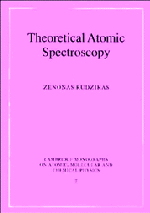Book contents
- Frontmatter
- Contents
- Preface
- Foreword to the Paperback Edition
- Introduction
- Part 1 Energy Spectrum of Many-electron Atom. Radiative and Autoionizing Transitions (Initial Formulas)
- Part 2 Foundations of the Angular Momentum Theory. Graphical Methods
- 5 Angular momentum and tensorial algebra
- 6 Main quantities of angular momentum theory
- 7 Angular momentum theory for relativistic case
- 8 Graphical methods: their generalization for perturbation theory
- Part 3 Description of Complex Electronic Configurations
- Part 4 Second-quantization in the Theory of an Atom. Quasispin and Isospin
- Part 5 Matrix Elements of the Energy Operator
- Part 6 Electric and Magnetic Multipole Transitions
- Part 7 Calculation of Energy Spectra and Electronic Transitions in the Case of Complex Configurations
- Epilogue
- References
- Index
5 - Angular momentum and tensorial algebra
Published online by Cambridge University Press: 21 September 2009
- Frontmatter
- Contents
- Preface
- Foreword to the Paperback Edition
- Introduction
- Part 1 Energy Spectrum of Many-electron Atom. Radiative and Autoionizing Transitions (Initial Formulas)
- Part 2 Foundations of the Angular Momentum Theory. Graphical Methods
- 5 Angular momentum and tensorial algebra
- 6 Main quantities of angular momentum theory
- 7 Angular momentum theory for relativistic case
- 8 Graphical methods: their generalization for perturbation theory
- Part 3 Description of Complex Electronic Configurations
- Part 4 Second-quantization in the Theory of an Atom. Quasispin and Isospin
- Part 5 Matrix Elements of the Energy Operator
- Part 6 Electric and Magnetic Multipole Transitions
- Part 7 Calculation of Energy Spectra and Electronic Transitions in the Case of Complex Configurations
- Epilogue
- References
- Index
Summary
Central field approximation, angular momentum and spherical functions
We have already mentioned the central field approximation in Chapter 1 while discussing the self-consistent field method and the zero-order Hamiltonian of many-electron atoms. Let us recall briefly its main idea. The central field approximation means that any given electron in the N-electron atom moves independently in the electrostatic field of the nucleus, which is considered to be stationary, and of the other N – 1 electrons. This field is assumed to be time-averaged over the motion of these N – 1 electrons and, therefore, to be spherically symmetric. Then the wave function of this electron will be described by a formula of the type (1.14). In any such central field, the wave function (1.14) will be an eigenfunction of L2 and Lz, where L is angular momentum of an electron, and Lz its projection. Thus, the angular momentum of the electron is a constant of motion, and the wave function of the type (1.14) is an eigenfunction of the one-electron angular and spin momentum operators L2, Lz and s2, sz with eigenvalues l(l + 1), mL and s(s + 1) = ¾, ms, correspondingly (in units of ħ2).
Thus, in the central field approximation the wave function of the stationary state of an electron in an atom will be the eigenfunction of the operators of total energy, angular and spin momenta squared and one of their projections. These operators will form the full set of commuting operators and the corresponding stationary state of an atomic electron will be characterized by total energy E, quantum numbers of orbital l and spin s momenta as well as by one of their projections.
- Type
- Chapter
- Information
- Theoretical Atomic Spectroscopy , pp. 37 - 47Publisher: Cambridge University PressPrint publication year: 1997

